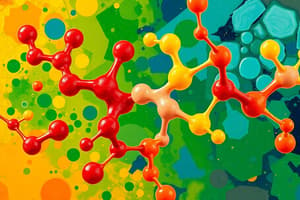Podcast
Questions and Answers
Match the biomolecule with its source:
Match the biomolecule with its source:
Carbohydrates = Vegetables, bread, whole grains Lipids = Dairy, oil, poultry Proteins = Nuts, beans, meat, fish Nucleic Acid = Parents DNA, RNA
Match the chemical reaction type with its description:
Match the chemical reaction type with its description:
Synthesis/Combination = Two or more reactants combine to form one product Decomposition = One reactant breaks down into two or more products Single replacement = One element is substituted for another element in a compound Double replacement = Two ionic compounds exchanging anions or cations
Match the evidence of a chemical reaction with its example:
Match the evidence of a chemical reaction with its example:
Change in color = Rusting Change in temperature = Cooking Evolution of gas = Formation of bubbles and vapor Emission of light = Burning
Match the statement about chemical equations with its description:
Match the statement about chemical equations with its description:
Match the factor affecting reaction rate with its definition:
Match the factor affecting reaction rate with its definition:
Match the method for balancing chemical equations with its steps:
Match the method for balancing chemical equations with its steps:
Match the Biomolecule Class with its description:
Match the Biomolecule Class with its description:
Match the Carbohydrate Type with its example:
Match the Carbohydrate Type with its example:
Match the Lipid Type with its function:
Match the Lipid Type with its function:
Match the Protein Type with its example:
Match the Protein Type with its example:
Match the Amino Acid Component with its description:
Match the Amino Acid Component with its description:
Match the Monomer Term with its meaning:
Match the Monomer Term with its meaning:
Flashcards are hidden until you start studying




